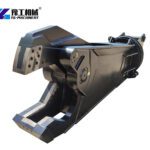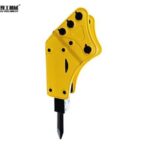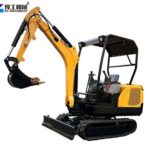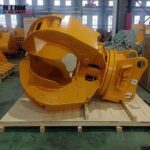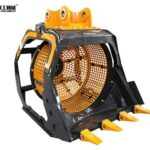Hydraulic shear attachment for excavator is a powerful excavator attachment designed to cut through heavy materials like steel, rebar, and concrete using hydraulic pressure. It is usually mounted on the excavator’s arm.
Key Components of the Hydraulic Shear Attachment for Excavator
Cutting Jaws: Hardened steel blades engineered for high-force shearing.
Hydraulic Motor: Converts the excavator’s hydraulic flow into mechanical force.
Rotation Mechanism: Allows 360° positioning for angled cuts (in rotating models).
Why Need a Hydraulic Shear?
1. Enhanced Productivity
Cut through materials 3x faster than manual methods.
Reduce downtime with quick attachment swaps.
2. Versatility Across Applications
Demolition, scrap processing, industrial dismantling, and concrete cutting.
3. Cost Savings
Lower labor costs and reduced waste via precise material segregation.
4. Durability
Built with abrasion-resistant materials for extended lifespan.
Hydraulic Shears Working Principle
Hydraulic shear attachment for the excavator leverages the excavator’s hydraulic system to generate immense force. Here’s a step-by-step breakdown:
1. Hydraulic Fluid Activation: The excavator’s pump sends pressurized fluid to the shear’s motor.
2. Force Amplification: A piston converts hydraulic pressure into mechanical energy, driving the jaws.
3. Material Shearing: Blades to slice through thick steel beams or reinforced concrete.
Types of hydraulic Hydraulic Shear Attachment for Excavator
1. Demolition Shears
Use Case: Crushing concrete, cutting rebar, and dismantling structures.
Features: Reinforced blades, multi-axis rotation.
2. Scrap Processing Shears
Use Case: Recycling yards for slicing cars, appliances, and metal waste.
Features: High cycle times, wear-resistant teeth.
3. Rotating vs. Fixed Shears
Rotating: 360° movement for precise cuts in tight spaces.
Fixed: Higher force output for heavy-duty demolition.
Choosing the Right Hydraulic Shear: A Buyer’s Checklist
1. Excavator Compatibility
Match weight class
Verify hydraulic flow
2. Material Type
Hardened steel blades for reinforced concrete; serrated edges for scrap metal.
3. Job Requirements
Demolition: Prioritize rotation and jaw opening width.
Scrap Processing: Focus on cycle speed and durability.
Applications: Where Hydraulic Shears Excel
Demolition Sites: Rapidly dismantle steel frameworks and concrete walls.
Scrap Yards: Process automobiles, railcars, and white goods efficiently.
Industrial Dismantling: Safely decommission factories or pipelines.
Emergency Response: Clear debris post-disaster with precision.
Maintenance Best Practices for Longevity
Daily: Inspect blades of the hydraulic shear attachment for the excavator for wear, and check hydraulic hoses for leaks.
Monthly: Lubricate pivot points; replace seals if fluid contamination occurs.
Annually: Overhaul the hydraulic motor and test pressure settings.
Red Flag: Jerky movements or reduced cutting force often indicate hydraulic issues or blade dullness.

